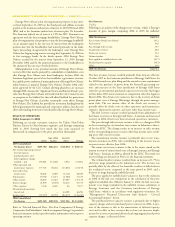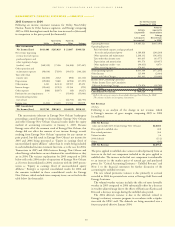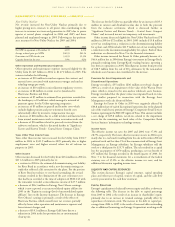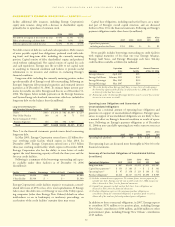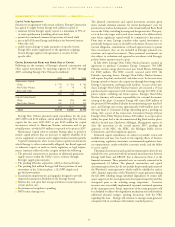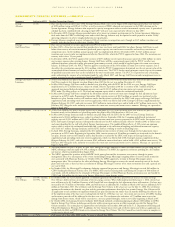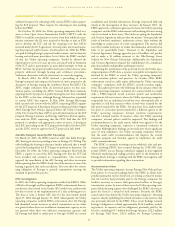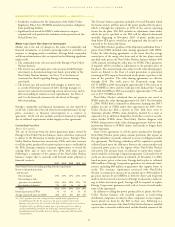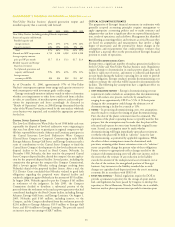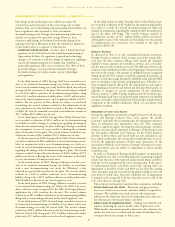Entergy 2006 Annual Report Download - page 54
Download and view the complete annual report
Please find page 54 of the 2006 Entergy annual report below. You can navigate through the pages in the report by either clicking on the pages listed below, or by using the keyword search tool below to find specific information within the annual report.
ENTERGY CORPORATION AND SUBSIDIARIES 2
2000066
38
In addition to the regulatory scrutiny connected with base rate
proceedings, the Utility operating companies’ fuel and purchased power
costs recovered from customers are subject to regulatory scrutiny. The
Utility operating companies’ significant fuel and purchased power
cost proceedings are described in Note 2 to the financial statements.
FEDERAL REGULATION
The FERC regulates wholesale rates (including Entergy Utility
intrasystem sales pursuant to the System Agreement) and interstate
transmission of electricity, as well as rates for System Energy’s sales of
capacity and energy from Grand Gulf to Entergy Arkansas, Entergy
Louisiana, Entergy Mississippi, and Entergy New Orleans pursuant to
the Unit Power Sales Agreement.
System Agreement Proceedings
The Utility operating companies historically have engaged in the
coordinated planning, construction, and operation of generating and
bulk transmission facilities under the terms of the System Agreement,
which is a rate schedule that has been approved by the FERC. The
LPSC has been pursuing litigation involving the System Agreement at
the FERC. The proceeding includes challenges to the allocation of
costs as defined by the System Agreement and raises questions of
imprudence by the Utility operating companies in their execution of
the System Agreement.
In June 2005, the FERC issued a decision in the System Agreement
litigation, and essentially affirmed its decision in a December 2005 order
on rehearing. The FERC decision concluded, among other things, that:
■The System Agreement no longer roughly equalizes total
production costs among the Utility operating companies.
■In order to reach rough production cost equalization, the FERC
will impose a bandwidth remedy by which each company’s total
annual production costs would have to be within +/- 11% of
Entergy System average total annual production costs.
■In calculating the production costs for this purpose under the
FERC’s order, output from the Vidalia hydroelectric power plant
will not reflect the actual Vidalia price for the year but is priced at
that year’s average price paid by Entergy Louisiana for the
exchange of electric energy under Service Schedule MSS-3 of the
System Agreement, thereby reducing the amount of Vidalia costs
reflected in the comparison of the Utility operating companies’
total production costs.
■The remedy ordered by FERC calls for no refunds and will be
effective based on calendar year 2006 production costs with the
first potential reallocation payments, if required, to be made
in 2007.
The FERC’s decision would reallocate total production costs of the
Utility operating companies whose relative total production costs
expressed as a percentage of Entergy System average production costs
are outside an upper or lower bandwidth. This would be accom-
plished by payments from Utility operating companies whose
production costs are more than 11% below Entergy System average
production costs to Utility operating companies whose production
costs are more than the Entergy System average production cost, with
payments going first to those Utility operating companies whose total
production costs are farthest above the Entergy System average.
An assessment of the potential effects of the FERC’s decision
requires assumptions regarding the future total production cost of
each Utility operating company, which assumptions include the mix
of solid fuel and gas-fired generation available to each company and
the costs of natural gas and purchased power. Entergy Louisiana,
Entergy Gulf States, and Entergy Mississippi are more dependent
upon gas-fired generation sources than Entergy Arkansas or Entergy
New Orleans. Of these, Entergy Arkansas is the least dependent upon
gas-fired generation sources. Therefore, increases in natural gas prices
likely will increase the amount by which Entergy Arkansas’ total pro-
duction costs are below the average total production costs of the
Utility operating companies.
Considerable uncertainty exists regarding future gas prices. For
purposes of the August 2006 Entergy Arkansas general base rate case
filing discussed above in “State and Local Rate Regulation,” an assess-
ment of the potential effects of the FERC’s June 2005 order, as
amended by its December 2005 order on rehearing, was calculated on
the basis of a 2006 test year, using a 2006 gas price that consisted of
a non-weighted average of twelve months of gas prices calculated as
follows: January through May 2006 were actual, volume-weighted
monthly averages of day-ahead cash prices as reported by Energy
Intelligence Natural Gas Week; the June 2006 price was the First of
the Month Index price as reported by Platts Inside FERC’s Gas
Market Report; the July 2006 price was the 5/31/06 NYMEX Henry
Hub settlement price; and August through December 2006 were 30
calendar-day rolling averages as of May 31, 2006 of forward NYMEX
Henry Hub gas contracts. For example, the August 2006 price was an
average of all the daily NYMEX settlement prices for the August 2006
contract for each trading day from the period 5/2/06 - 5/31/06
inclusive. A similar calculation was made using the daily settlements
of the September 2006 through December 2006 NYMEX contracts
to arrive at those monthly prices. This resulted in an average annual
gas price of $7.49/mmBtu. If an annual average gas price of
$7.49/mmBtu occurred for 2006 as assumed, the following potential
annual production cost reallocation among the Utility operating com-
panies could result (in millions):
Annual Payment
or (Receipts)
Entergy Arkansas $ 284
Entergy Gulf States $(197)
Entergy Louisiana $ (59)
Entergy Mississippi $ (28)
Entergy New Orleans $ –
If the actual, annual, average natural gas price deviates by $1/mmBtu
up or down from the price assumed above, it is expected that Entergy
Arkansas’ annual payments will change in the same direction by
approximately $70 to $80 million.
The LPSC, APSC, MPSC, and the AEEC have appealed the FERC
decision to the Court of Appeals for the D.C. Circuit. Entergy and
the City of New Orleans have intervened in the various appeals. The
parties to the proceeding reached agreement on a proposed briefing
schedule that would result in the completion of briefing during the
first half of 2007. The proposed briefing schedule has been submitted
to the Court of Appeals.
Management believes that any changes in the allocation of produc-
tion costs resulting from the FERC’s decision and related retail
proceedings should result in similar rate changes for retail customers.
The timing of recovery of these costs in rates could be the subject of
additional proceedings before Entergy’s retail regulators. Although the
outcome and timing of the FERC and other proceedings cannot be
predicted at this time, Entergy does not believe that the ultimate res-
olution of these proceedings will have a material effect on its financial
condition or results of operations.
Entergy’s Utility Operating Companies’ Compliance Filing
In April 2006, the Utility operating companies filed with the FERC
its compliance filing to implement the provisions of the FERC’s
decision. The filing amends the System Agreement to provide for the
calculation of production costs, average production costs, and
MANAGEMENT’S FINANCIAL DISCUSSION and ANALYSIS continued


